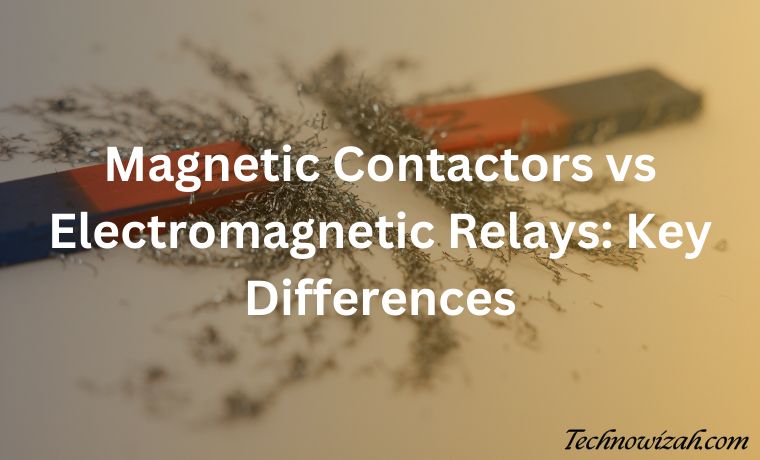Magnetic Contactors vs Electromagnetic Relays: Key Differences – The field of electrical components can be intricate, particularly for individuals unfamiliar with the devices that power our daily routines. Among these components, magnetic contactors and electromagnetic relays may initially appear similar. However, they fulfill distinct functions within electrical systems.
 Magnetic Contactors vs Electromagnetic Relays: Key Differences
Magnetic Contactors vs Electromagnetic Relays: Key Differences
Both electromagnetic relays and magnetic contactors operate based on the principle of electromagnetism. When an electrical current goes through a coil of wire, it produces a magnetic field. This field can physically open or close electrical contacts within the device. This mechanism enables the remote control and switching of circuits, making them indispensable elements in a variety of electrical applications.
Built to Handle the Big Jobs: Magnetic Contactors
Magnetic contactors are renowned for their strong performance in electrical switching. Engineered to manage high electrical currents, they boast sturdy construction and sizeable contacts to handle augmented power transmission effectively. The distinguishing features of magnetic contactors are as follows:
- High Current Capacity: A magnetic contactor’s primary function is to control high-power circuits. It is typically used in industrial applications like motor control, large lighting systems, and power distribution and can effectively handle AC and DC loads.
- Heavy-Duty Construction: Due to the higher currents involved, magnetic contactors are physically larger and more reliable than relays. They often incorporate features like arc suppression coils to minimize damage caused by electrical arcing during switching.
- Single Circuit Control: Magnetic contactors are typically designed to control a single main circuit, either single-phase or three-phase. While some contractors may have auxiliary contacts for control functions, their primary focus is handling high-power loads.
The All-Rounders: Electromagnetic Relays
Electromagnetic relays are highly versatile components widely used in electrical control systems, particularly for managing lower to medium current loads. Their compact size and diverse contact configurations make them well-suited for a range of applications. Below are some key characteristics of electromagnetic relays:
- Lower Current Capacity: Electromagnetic relays are perfect for controlling circuits with smaller loads, such as solenoids and indicator lights, and for controlling circuits within larger systems.
- Compact Design: Relays are typically smaller and lighter than magnetic contactors, making them suitable for applications where space is a constraint. They come in various configurations with different contact arrangements (normally open, normally closed, or combinations) to suit specific needs.
- Multiple Circuit Control: Unlike magnetic contactors that focus on a single main circuit, relays can be used to control multiple circuits simultaneously. This flexibility allows for more complex control logic within a system.
Choosing the Right Tool
Selecting between a magnetic contactor and an electromagnetic relay depends on the specific application’s requirements. Here’s a quick guide:
- High Current Loads: Choose a magnetic contactor for its robust construction and high current capacity.
- Lower Current Loads: An electromagnetic relay is ideal for its versatility and ability to handle multiple circuits.
- Space Constraints: If space is limited, a compact electromagnetic relay might be the better choice.
- Control Complexity: For applications requiring control of multiple circuits with varying configurations, an electromagnetic relay offers greater flexibility.
Partnering for Success
When handling electrical components, particularly items such as magnetic contactors and electromagnetic relays, it is imperative to collaborate with reputable energy brands. These brands provide not only high-quality products but also valuable resources such as technical support, application expertise, and comprehensive safety training.
Reputable energy brands prioritize safety and ensure that their products comply with relevant industry standards. They can assist in selecting the appropriate component for specific requirements, and optimizing performance and system longevity. Partnering with a trusted brand provides access to a wealth of knowledge and expertise, which is essential for the success and safety of an electrical project.
Choosing the Right Electrical Components for Your Project
While both employ electromagnetism, magnetic contactors, and electromagnetic relays serve distinct purposes. Understanding their key differences in terms of current capacity, construction, and control capabilities is essential for selecting the right component for your electrical application. By making the right choices and working with trusted partners, you can ensure the smooth and efficient operation of your electrical systems.
Don’t forget to bookmark and always visit every day Technowizah.com because you can find here the latest Tech Computer Android games How-to Guide Tips&Tricks Software Review etc, Which we update every day.



![How To Fix Corel Draw Cannot Save on X5, X7, X8 [2025] How To Fix Corel Draw Cannot Save on X5, X7, X8](https://technowizah.com/wp-content/uploads/2021/11/How-To-Fix-Corel-Draw-Cannot-Save-on-X5-X7-X8-218x150.jpg)

![Download Latest SuperSU ZIP Root Files Apk [Official] 2025 Download Latest SuperSU ZIP Root Files Apk [Official]](https://technowizah.com/wp-content/uploads/2021/04/Download-Latest-SuperSU-ZIP-Root-Files-Apk-Official-218x150.jpg)






![10+ Ways To Take Screenshot on Asus Laptop Windows 10 [2024] How To Take Screenshot on Laptop and PC Windows](https://technowizah.com/wp-content/uploads/2020/06/How-To-Take-Screenshot-on-Laptop-and-PC-Windows-100x70.jpg)
